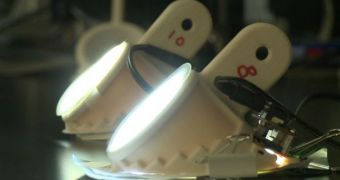In a groundbreaking achievement, experts at RTI International announce the development of a new type of lighting technology. The method is purported as being considerably more efficient than compact fluorescent light (CFL), which is currently being implemented worldwide as an alternative to traditional light bulbs. Additionally, solid-state lighting devices do not contain mercury, which means that they are also more environmentally friendly than CFL is. The RTI group reveals that the foundation for its innovation was laid using an advanced polymer nanofiber structure, PhysOrg reports.
The team adds that this approach allowed it to obtain an unprecedented level of power management out of the new devices. The work was partially made possible by grant money secured under the US Department of Energy's (DOE) Solid-State Lighting program. The stated goal was to design and produce high-performance, nanofiber-based reflectors and photoluminescent nanofibers (PLN). This was achieved by putting the chemical and physical properties of nanoscale materials to work in producing light that did not require tremendous amounts of electricity to provide levels of luminosity similar to the ones incandescent light bulbs and CFL bulbs could provide.
The end-result of the investigation was a source of light that was capable of producing 55 lumens of output for every watt of electricity consumed. This level of efficiency is about five times greater than the one currently available with the most advanced incandescent bulbs. “By using flexible photoluminescent nanofiber technologies for light management, RTI has opened the door to the creation of new designs for solid-state lighting applications. This new class of materials can provide cost-effective, safe and efficient lighting solutions,” the RTI Nanoscale Materials Program Director, Lynn Davis, PhD, says.
“Because lighting consumes almost one-fourth of all electricity generated in the United States, our technology could have a significant impact in reducing energy consumption and carbon dioxide emissions. The technology also does not contain mercury, which makes it more environmentally friendly and safer to handle than CFLs and other fluorescent lamps,” Davis adds. According to the team, the technology could hit the shelves within three to five years, if the necessary funding to continue development can be secured.

 14 DAY TRIAL //
14 DAY TRIAL //